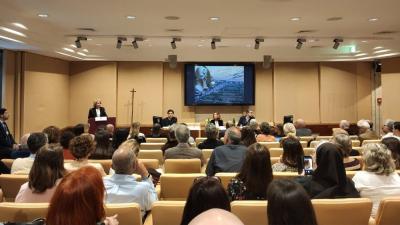Egyptian Goddess Sekhmet target of new Vatican Museums research project

VATICAN CITY - The Sekhmet Project, directed by the Vatican Museums with the support of the Canadian Patrons of the Arts group, is a research project looking at the sculptural production of hundreds of statues of the goddess Sekhmet. Sekhmet was the ancient Egyptian goddess of war and healing, daughter of the Sun God, Ra. The research into the statues, made in the reign of Amenhotep III (a Pharoah born in 1400 BC) for his funerary temple at Kom el-Hettan in Egypt, is now being presented to the public.
The Sekhmet statues date back to the New Kingdom of Egypt (16th century BC - 11th century BC) and were found thoughout Egypt and other parts of northern Africa. They were created for Pharoah Amenhotep III who hoped that the statues would heal him from illness and bring him good fortune.
The project, laid out in a press conference on Thursday, is focused on the study of the sculptural production of the goddess Sekhmet, in order to reconstruct their original arrangement within the temple, including their technical construction and the organisation of the gigantic building site.
It was set up in 2016 following the restoration of the Sekhmet statues conserved in the Vatican Museums, then extended to include the larger collection of Sekhmet statues in the Museo Egizio in Turin.
The Director of the Museums, Barbara Jatta, at the conference on Thursday spoke about the importance of Egypt in the Vatican collections. “Extraordinary discoveries continue to be made in the Egyptian valleys and this project is an emblem of our museums which promote cultural and scientific exchanges.”
The first phase of the project carried out the restoration of the eleven statues housed in the Gregorian Egyptian Museum. The conservation work - carried out by the firm Decesaris under the supervision of the Vatican Museums' Laboratory for Restoration of Stone Materials and the Diagnostic Laboratory for Conservation and Restoration, with the support of the Patrons of the Arts in the Vatican Museums (Canada Chapter) - yielded important scientific results that were subsequently developed jointly with the Egyptian Museum of Turin, which in turn holds 23 statues of the goddess Sekhmet.
Alessia Armenta, the department curator, commented on the importance of the figure of Sekhmet saying “Sekhmet is the goddess with a lion's head, she is a frightening goddess, a terrible one... But, she also has a feline aspect, she also has a softer side.”
Towards the end of the conference, Stefano Mastrostefano, the computer engineer and expert, highlighted the innovative aspects of the project and their use of AI. “Today, archaeometry goes hand in hand with archaeology. We can only be pleased to be able to study the material with all the scientific investigations applied to cultural heritage…With the creation of a dedicated software, which with a play on words we have called Seek-hmet, we are convinced that we can make these numbers speak for themselves and find answers to our questions.”
eb-cw
© COPYRIGHT ITALIAN INSIDER
UNAUTHORISED REPRODUCTION FORBIDDEN


